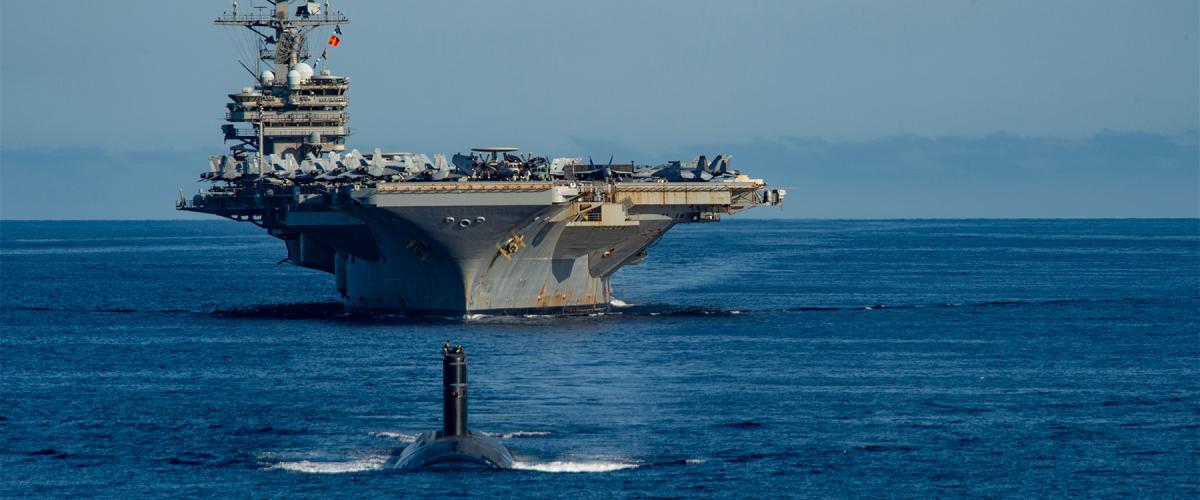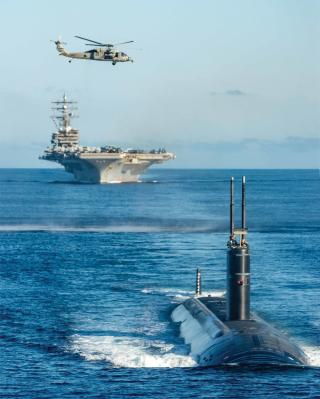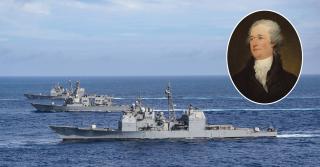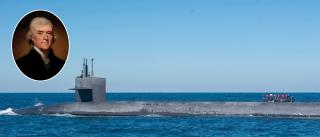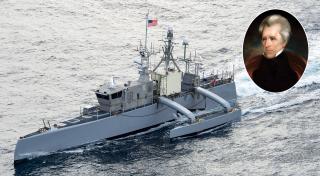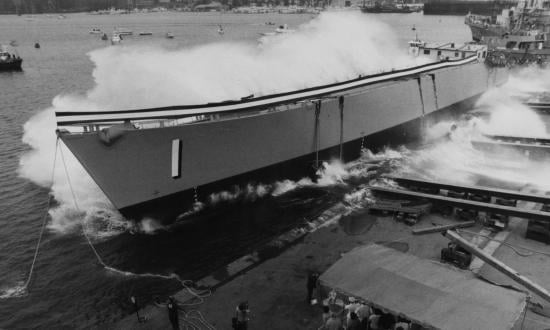For some years now, there has been a sense in Washington that the Navy is strategically bankrupt.1 Given steep cost overruns on shipbuilding programs, maintenance backlogs across both public and private shipyards, and the seeming inability to increase the fleet’s hull count, several members of Congress have expressed frustration at what they see as the Navy’s lack of direction. In a 2021 op-ed, then–Representative Elaine Luria of Virginia wrote, “The Navy lacks a comprehensive maritime strategy that defines what the Navy needs to do, how it needs to do it, the resources required, and how to manage risk if those resources aren’t available.”2 Her colleague on the House Armed Services Committee, Representative Mike Gallagher of Wisconsin, argued that the Navy “is apparently incapable of providing Congress a direct and consistent answer [to the number of ships it needs to] deter—and if necessary win—a war.”3 Both members supported a provision in the 2023 National Defense Authorization Act establishing a commission to review the Navy’s force structure and, more broadly, the service’s future.4
These lawmakers essentially were telling the Navy that if only it had a coherent strategy, Congress would be on board to resource it. This offers both a challenge and an opportunity for the Navy’s leaders. While future shipbuilding strategies could face closer scrutiny than the service has been accustomed to in recent years, the Navy has a chance to argue for transformational change in both its funding levels and its force structure. This could mean a once-in-a-generation opportunity to properly resource the service. But the Navy must walk this path carefully, because unless it proposes a strategy that matches means with ends, it will fail to make a change.
Part of the problem may be that the Navy has not considered the foreign policy ends its strategy should be designed to serve. As Representative Luria pointed out, the Navy’s strategic documents fall short because although they identify renewed great power competition as the Navy’s primary challenge, they fail to match foreign policy ends with the resourcing—the means—that would be needed to confront this policy challenge.5 It is incumbent on the Navy’s leaders, then, to consider foreign policy and be frank about where different policy paths could lead. Navalists must lay out well-reasoned arguments for why one plan for shipbuilding or force structure would serve the nation’s foreign policy interests better than another. Only then can the nation get a clear-eyed understanding of the naval forces that will be needed to carry out its political objectives.
Schools of Foreign Policy and the Navy
The nation’s foreign policy priorities will shape the character of the Navy. A useful tool for thinking about what the fleet would look like under different foreign policy paradigms is the model of the four “classic” schools of American foreign policy thought: Hamiltonian, Wilsonian, Jeffersonian, and Jacksonian.
Hamiltonian Foreign Policy
Hamiltonian foreign policy prioritizes U.S. global trade interests. It relies on realist concepts such as the balance of power or the use of force to settle problems in international relations.6 Hamiltonian foreign policy values freedom of the seas, which implies the need for a competent maritime force with enough capacity to gain and maintain local sea control at any location and at any time. Its ships also must be visible, meaning it must show the flag to deter aggressive behavior from potential adversaries.
A Hamiltonian naval policy would favor investment in powerful surface units that not only can destroy the enemy’s surface and subsurface combatants but also can escort merchants and defend them from attack. The aircraft carrier is the keystone in the Hamiltonian navy—a symbol of hard power that Presidents can send into hot spots to protect U.S. interests and deter bad behavior. Attack submarines and surface combatants provide supporting fires to amplify the lethality of the carrier strike group, helping to secure sea control and protect the lanes of commerce that Hamiltonians hold dear.
If this sounds familiar, it is because U.S. foreign policy has been primarily Hamiltonian since the U.S. Navy became the world’s predominant maritime force in the 20th century.
Wilsonian Foreign Policy
Like Hamiltonian foreign policy, Wilsonian policy demands global reach. The namesake of Woodrow Wilson, who told Congress in 1917 that the world must be made safe for democracy, Wilsonian foreign policy insists that the United States has the right and duty to intervene in the domestic policies of other nations.7 It calls for a global presence for the sake of expanding democracy. Wilsonian foreign policy recently has fallen out of favor because of the failed post-9/11 nation-building efforts in the Middle East, but it nonetheless was the dominant foreign policy paradigm for more than 20 years, from the unipolar moment after the Cold War until the 2010s, when great power rivalry again began to take center stage.
A feature of Wilsonian foreign policy is inland power projection. It values the capability to strike deep into a land mass with aircraft and land-attack cruise missiles and favors platforms that extend air dominance over land. As in the Hamiltonian navy, the carrier is the central unit of the Wilsonian navy, but it is the air wing’s inland strike capability, not the symbolic deterrent power of the carrier itself, that is the source of power. Indeed, carrier air power was key to the initial military success of the post–11 September invasions of Iraq and Afghanistan. The number of vertical launch system tubes in theater also is a key metric in Wilsonian foreign policy. Units such as the guided-missile submarine, cruiser, and destroyer are crucial supporting platforms to the carrier air wing.
Thus, although this foreign policy paradigm is going out of fashion, much of the Navy’s current force structure is a result of Wilsonian maritime strategy.
Jeffersonian Foreign Policy
In recent years, Jeffersonian foreign policy has gained popularity in Washington and political support among voters. Named for the third president, it is rooted in the belief that American democracy is suitable only for the United States and a very few others. During his presidency, Jefferson famously advocated for a fleet of small, shallow-draft gunboats intended for coastal defense rather than for going far afield.8 This conforms with the overall Jeffersonian tenet that war should be the last resort of foreign policy.9
Wilsonian nation-building efforts have no place in this paradigm, nor do the globalist Hamiltonian policies of protecting U.S. trade interests. For these reasons, Jeffersonian foreign policy has been associated with inwardness and isolationism. The military’s role in this paradigm is solely to defend the nation’s territory from attack; defensive capabilities become paramount.
Today, a Jeffersonian navy would invest heavily in ballistic-missile defense; the ballistic-missile submarine would be the Jeffersonian capital ship, with its arsenal of strategic nuclear weapons providing the main deterrent against any attempt to attack U.S. territory. Meanwhile, the country would divest of many of the expensive units meant for power projection, such as the aircraft carrier. The savings from a much lower defense budget would be reinvested in the domestic economy to bolster the U.S. democratic institutions that Jeffersonians cherish.
A shift to a Jeffersonian navy would be a dramatic change, but it would not be impossible given the support on the extreme ends of today’s political spectrum for reducing the defense budget.
Jacksonian Foreign Policy
The fourth classic school of American foreign policy, the Jacksonian school, is more difficult to characterize. It is another paradigm that was quiescent for some time after the end of the Cold War but has gained traction in foreign policy circles in recent years, especially during the presidency of Donald Trump. Jacksonian foreign policy focuses on preserving America’s honor; it wields power to assert American greatness.10 It is also concerned with protecting American blood and treasure. Thus, it is skeptical of any kind of military effort that does not directly serve U.S. interests. It often views overseas military commitments and consistent global presence as wasteful.
Jacksonian foreign policy shares Jeffersonian skepticism of interventionist, global foreign policy. It differs from Jeffersonian isolationism, however, in that it favors waging war at the highest possible intensity once the United States commits to fighting.11
Therefore, Jacksonian foreign policy demands a highly capable force that can deliver lethality anywhere when required. Naval planning would be numbers-obsessed: Any suggestion that an adversary such as China has surpassed the Navy’s power would be unacceptable, and, therefore, more hulls would need to be built—and fast—to retake the prestige of having the world’s largest navy. Yet Jacksonians also would want to limit the risk to American blood; unmanned technology would thus be a big part of the Jacksonian investment strategy.
Perhaps unsurprisingly, a Jacksonian navy would look much like the one laid out in the 2020 shipbuilding plan under Secretary of Defense Mark Esper, which included a massive ramp-up in the number of hulls, including a heavy investment in unmanned surface vessels to contribute to the overall hull count.12
A New Political Path?
To most effectively argue for its future resources, the Navy must know the foreign policy ends it is serving. It must therefore think about where U.S. foreign policy is trending. Until recently, the Hamiltonian and Wilsonian schools dominated, although, today, the Jeffersonian and Jacksonian schools are growing in popularity. Even after Donald Trump’s 2020 election defeat, Jacksonian thinking is still highly popular among many Americans. Jeffersonian foreign policy has found advocates, too. Politicians such as Senator Rand Paul of Kentucky, as well as scholars in academia and some Washington think tanks, argue for a less engaged foreign policy.
Still, Hamiltonian policy is not going away anytime soon. The United States is waking up to the threat posed by China’s aspiration for hegemony over East Asia; if China were able to dominate the region, it could both threaten U.S. commercial interests there and degrade U.S. influence and credibility nearly anywhere.13 There is a Jacksonian component to U.S. China policy as well, as supporters of this paradigm fear the dishonor that would result if the United States “lost” a great power conflict. Even if the U.S. population no longer has much appetite for new free trade agreements, most of the public favors contesting China’s bid for hegemony in the western Pacific.14
With these foreign policy shifts in mind—Wilsonian support on the wane, and Hamiltonian, Jacksonian, and even Jeffersonian support growing—and with Congress’s growing interest in influencing maritime strategy, there are four ways the Navy can employ a more foreign policy–centered approach to help it craft a coherent strategy:
Frame funding challenges in foreign policy terms to help lawmakers make informed funding decisions. If the Navy presented its shipbuilding strategy in terms of these easy-to-understand schools of policy, it could better explain to Congress what it needs to match means, ways, and foreign policy ends. A practical example is the trilemma among the Next Generation Air Dominance platform (NGAD), the next-generation attack submarine (SSN[X]) and the next-generation guided-missile destroyer (DDG[X]). In 2021, then–Acting Secretary of the Navy Thomas Harker told Navy leaders they would have to choose one of the three programs to fund and that the other two would need to be rephased.15 Chief of Naval Operations Admiral Michael Gilday continues to express how challenging it will be to balance their funding going forward.16
To tackle this challenge, the Navy should determine where its foreign policy mandate lies. Then, it should characterize its choices in foreign policy terms. For example, prioritizing NGAD would mean prioritizing carrier-based power projection—a more Wilsonian strategy. Prioritizing DDG(X) would imply a more Hamiltonian mandate, because advanced destroyers would show the flag and thus the global reach of U.S. power. SSN(X) is more of a Jeffersonian platform because it would excel at defending friendly ballistic-missile submarines and denying sea control to U.S. adversaries. Understanding funding challenges in these terms would help the Navy prioritize to meet the intent of political leaders; it would thus be better poised to work with Congress to achieve policy goals.
Use the language of foreign policy to explain the Navy’s limitations to Congress and the public. A recent critique of the Navy is that it has prioritized forward presence too much over longer-term readiness.17 In other words, the Navy is trying to maintain a Hamiltonian global presence with a Jeffersonian budget. If the Navy explained the limits of fleet size and operations in these terms, it would help articulate to Congress and the public that it cannot do everything at once. If the nation wants to maintain forward presence operations to protect commerce and engage with the world, it will need to allocate more resources to build hulls. If it wants a less engaged global role, then the Navy will not be able to fulfill its traditional Hamiltonian role of protecting sea lines of communication. But it cannot have it both ways.
Likewise, if the public’s policy preference is to minimize risk to American blood and treasure but at the same time maintain exquisite warfighting capability—in other words, a Jacksonian foreign policy mandate—then the Navy must explain the trade-offs. It can invest heavily in unmanned units to minimize risk to personnel, but those units’ lethality might be limited because of the ethical concerns involved with using unmanned systems for lethal effects. Building the highly capable fleet that Jacksonian foreign policy advocates want still would require a huge investment, both in terms of personnel and resourcing.
Root the maritime investment strategy in foreign policy ends to make a more compelling argument for why the Navy deserves greater resourcing. If policy-makers decide, as it looks like they will, that protecting U.S. interests in the western Pacific and deterring China is the policy priority, then the Navy can point to what Hamiltonian and Jacksonian foreign policy prescribes: greater presence and more hulls. The Navy can then make a clearer case that the only way to achieve these foreign policy ends would be to dramatically increase the budget to build the hulls and pay for the forward presence operations.
Navy leaders no doubt are wary of pushing too hard for large deviations from the President’s budget because they want to avoid the perception that they are out of alignment with political leaders. But today’s funding levels already are out of alignment with the nation’s foreign policy objectives. By bringing the debate back to a foreign policy–centric approach, the Navy would not be out of line when it asks for more funding.
Seek political allies who already articulate clear foreign policy objectives that align with the Navy’s strategic aims. Since the Civil War, the Navy has succeeded in enacting transformational change when it has partnered with charismatic political leaders who shared its strategic vision of both the policy ends and the means required to achieve them. Take, for example, Theodore Roosevelt’s campaign to build a world-class navy in the late 19th and early 20th centuries, both as Assistant Secretary of the Navy and as President, which resulted in the building of the Great White Fleet and put the United States in position to take over global naval primacy from Great Britain. Also consider President Ronald Reagan, who with Secretary of the Navy John Lehman led the effort to build a 600-ship Navy in the 1980s that helped defeat the Soviet empire. In both cases, political leaders and the Navy teamed with clear foreign policy goals and made the case to the American people for why the Navy needed big increases in resourcing.
Controlling Its Own Destiny
Starting with a foreign policy end in mind is key to crafting a coherent maritime strategy. If the Navy framed its strategic plans in terms of foreign policy paradigms, it could more easily convince the public and Congress to properly resource it. No longer would it have to overextend itself by doing forward presence missions while struggling to build the capacity of the fleet (and maintain it) with a limited pool of resources.
It also would be in a better position to control its own destiny. If the Navy cannot craft a strategy that matches military means with political ends, then political bodies will craft one for it. This is not to argue that civilian control of the military is a bad thing. On the contrary, civilian support is key to resource the Navy properly so it can achieve its foreign policy objectives. But the Navy should be open about what it needs and what its limitations are.
1. Christopher Dougherty, “Gradually and Then Suddenly: Explaining the Navy’s Strategic Bankruptcy,” War on the Rocks, 30 June 2021.
2. Elaine Luria, “Look to the 1980s to Inform the Fleet of Today,” War on the Rocks, 14 June 2021.
3. “Gallagher: ‘Congress Must Step In and Help Navy Avert Disaster,’” press release, Office of Congressman Mike Gallagher, 25 July 2022.
4. Justin Katz, “Will Congress and Navy Find Room to Agree on Ships? 2023 Preview,” Breaking Defense, 28 December 2022.
5. Luria, “Look to the 1980s.”
6. Walter Russell Mead, Special Providence: American Foreign Policy and How It Changed the World (New York: Routledge, 2013), 99.
7. Mead, Special Providence, 138.
8. Ian W. Toll, Six Frigates: The Epic History of the Founding of the U.S. Navy (New York: W. W. Norton & Company, 2008), 284.
9. Mead, Special Providence, 190.
10. Mead, 231.
11. Mead, 221.
12. Meghan Eckstein, “SECDEF Esper Calls for 500-Ship Fleet by 2045, With 3 SSNs a Year and Light Carriers Supplementing CVNs,” USNI News, 6 October 2020.
13. Elbridge Colby, The Strategy of Denial: American Defense in an Age of Great Power Conflict (New Haven, CT: Yale University Press, 2021), 13.
14. Laura Silver, Kat Devlin, and Christine Huang, “Most Americans Support Tough Stance Toward China on Human Rights, Economic Issues,” Pew Research Center’s Global Attitudes Project (blog), 4 March 2021.
15. Megan Eckstein, “Memo Reveals U.S. Navy Must Pick between Future Destroyer, Fighter or Sub for FY23 Plan,” Defense News, 8 June 2021.
16. Sam LaGrone, “CNO Gilday: Next-Generation Air Dominance Will Come Ahead of DDG(X) Destroyer,” USNI News, 18 January 2023.
17. Hon. Robert Work, “A Slavish Devotion to Forward Presence Has Nearly Broken the U.S. Navy,” U.S. Naval Institute Proceedings 147, no. 12 (December 2021).



